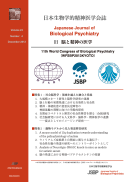Volume 23, Issue 4
Displaying 1-13 of 13 articles from this issue
- |<
- <
- 1
- >
- >|
-
2012Volume 23Issue 4 Pages 237
Published: 2012
Released on J-STAGE: February 16, 2017
Download PDF (136K) -
2012Volume 23Issue 4 Pages 239-244
Published: 2012
Released on J-STAGE: February 16, 2017
Download PDF (293K) -
2012Volume 23Issue 4 Pages 245-248
Published: 2012
Released on J-STAGE: February 16, 2017
Download PDF (197K) -
2012Volume 23Issue 4 Pages 249-254
Published: 2012
Released on J-STAGE: February 16, 2017
Download PDF (268K) -
2012Volume 23Issue 4 Pages 255-261
Published: 2012
Released on J-STAGE: February 16, 2017
Download PDF (339K) -
Neuroimaging in social brain research : A tool linking social sciences, neuroscience, and psychiatry2012Volume 23Issue 4 Pages 263-266
Published: 2012
Released on J-STAGE: February 16, 2017
Download PDF (233K) -
2012Volume 23Issue 4 Pages 267-271
Published: 2012
Released on J-STAGE: February 16, 2017
Download PDF (259K) -
2012Volume 23Issue 4 Pages 273-279
Published: 2012
Released on J-STAGE: February 16, 2017
Download PDF (278K) -
2012Volume 23Issue 4 Pages 281-286
Published: 2012
Released on J-STAGE: February 16, 2017
Download PDF (254K) -
2012Volume 23Issue 4 Pages 287-291
Published: 2012
Released on J-STAGE: February 16, 2017
Download PDF (271K) -
2012Volume 23Issue 4 Pages 293
Published: 2012
Released on J-STAGE: February 16, 2017
Download PDF (119K) -
2012Volume 23Issue 4 Pages 295
Published: 2012
Released on J-STAGE: February 16, 2017
Download PDF (121K) -
2012Volume 23Issue 4 Pages 297
Published: 2012
Released on J-STAGE: February 16, 2017
Download PDF (284K)
- |<
- <
- 1
- >
- >|
